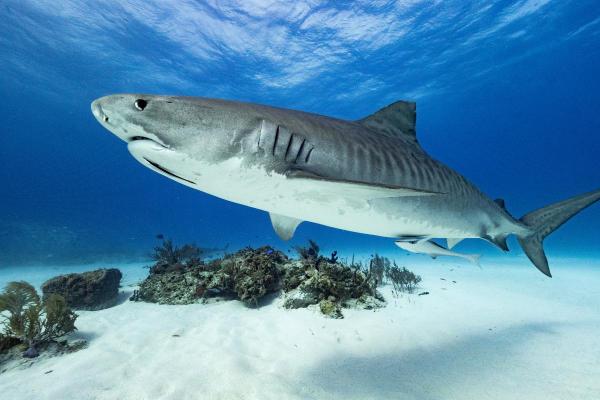Do Sharks Have Scales?


Sharks do have scales, despite them not being as obvious as other types of fish. As members of the class Chondrichthyes, they are considered cartilaginous fish. In addition to having skeletons mainly comprised of cartilage rather than bone, they have other characteristics features common to members of this class. It is commonly believed by many that sharks have skin. For those who have touched a shark, their skin doesn't feel the same as many other fish species. It is rough in texture, but it feels like one contiguous piece of skin rather than many scales together. This is thanks to something called dermal denticles in sharks.
AnimalWised helps us to understand more about shark biology by asking do sharks have scales? We do so by looking at the form of dermal denticles and how they function on the body of sharks.
Does a shark have scales or skin?
Determining whether sharks have skin or scales is complicated. It might be most accurate to say they have both skin and scales. This is because they have an organ which is considered to be shark skin. This shark skin is covered by small structures known as ‘dermal scales’, ‘dermal plates’ or ‘dermal denticles’.
These dermal scales are different from bony fish scales. They are usually harder and rougher to the touch. Dermal denticles often overlap and resemble small puzzle pieces, providing a protective layer for the shark. They also provide protection against ectoparasites, reduce mechanical abrasion and perform other functions.
Shark dermal scales are not identical to the scales of other fish, such as bony fish. Despite these structural differences, it is accurate to say sharks have scales. These shark scales are more flexible and are composed primarily of a material called dentin. This is similar to the tissue that makes up teeth in vertebrates. This structure allows them to be more resistant and durable, something essential for life in the marine environment.
Learn about how a shark's tongue works in our related article on shark anatomy.
What are shark scales like?
Dermal denticles of sharks are unique structures. As we mentioned before, they are different from the scales found on other fish. One of the most significant differences if the fact that dermal denticles are serrated. This is thanks to small points or teeth along their margins. These serrated features are one of the main distinctions between shark scales and the smooth scales of bony fish.
Shark scales are composed primarily of dentin. This is a hard tissue similar to that found in the teeth of other vertebrate animals. Dentin provides them with strength and durability. Although tough, shark dermal scales are more flexible than the scales of other fish. This allows them to move relatively freely underwater and adapt to the shape and movement of the shark's body.
These scales overlap each other in an arrangement that resembles shingles on a roof. This overlay provides protection and reduces water resistance. This is greatly beneficial for the agile and efficient swimming of sharks. Essentially, reducing water friction gives sharks exemplary hydrodynamics. Shark dermal scales also play an important role in resisting the shark's body against mechanical damage and regulating body temperature.
Discover how many fins a shark has to allow them for such hydrodynamic swimming.
Types of shark scales
Although dermal denticles have certain specific characteristics, their appearance and structure can vary between different shark species. Below are the examples of different shark scales:
- Normal dermal scales: these are the typical dermal scales found in most shark species. They are serrated on the edges, with small projections that give them a rough texture. These scales help reduce water resistance and act as small shields that protect the shark's body.
- Placoid dermal scales: these shark scales are harder and composed primarily of dentin. They are typical in bull, white and hammerhead sharks. They have a conical shape with a sharp center point. They are often found on the shark's fins, skin and mouth. Placoid scales are especially resistant and play an important role in protecting against mechanical damage.
- Modified dermal scales: some shark species have dermal scales that have uniquely evolved to adapt to their specific habitats and behaviors. For example, hammerhead sharks have wider T-shaped dermal scales on their pectoral fins, giving them greater ability to maneuver. Another case is seen in the whale shark. They have small dermal scales around the eyes, providing greater protection by acting as eyelids.
- Diamond-shaped dermal scales: some sharks have diamond-shaped dermal scales that overlap neatly in regular patterns, giving them a distinctive appearance on their skin.
It is worth mentioning that the variation in the type and structure of dermal scales may be due to the evolutionary adaptations of sharks to their specific environments and behaviors. These scales play an important role in the protection, hydrodynamics and survival of sharks in their marine habitat.
If you want to know more about different shark body parts, don't miss the following AnimalWised article on the anatomy of a shark.

How many scales does a shark have?
Determining the exact number of scales on a shark can be a difficult task. This number can vary depending on the species, the size of the individual shark and other factors. Rather than counting individual scales, scientists often focus on studying the morphology and arrangement of scales in relation to the adaptations of each shark species. This is how we have come to see so many different types of dermal denticles in sharks.
In order to provide an approximate number, some larger sharks may have tens of thousands of scales on their body. For example, the great white shark (Carcharodon carcharias) is one of the largest sharks and estimated to have about 3,000 to 4,000 dermal denticles or scales per 2.5 square centimeters of skin. The total surface area of an adult great white shark's skin is approximately 100 to 200 square feet (9 to 18.5 square meters), putting the number of denticles into the billions.
Shark dermal scales are continually replaced throughout their life. This replacement process is essential to maintain the integrity of their skin and ensure your ability to swim effectively. As worn or damaged scales fall off or wear away over time, new scales develop and take their place. This replacement process is occurs throughout the shark's entire life.
Continue learning about shark features with our articles on how many bones sharks have and how many teeth sharks have.

If you want to read similar articles to Do Sharks Have Scales?, we recommend you visit our Facts about the animal kingdom category.
- del Rosario Pani, M., & Cimarosti, LO (1979). Comparative histological study of the scales and teeth of the shark Squalus sp. Lilloana Zoological Act, 269-272.
- Domel, A.G., Domel, G., Weaver, J.C., Saadat, M., Bertoldi, K., & Lauder, G.V. (2018). Hydrodynamic properties of biomimetic shark skin: effect of denticle size and swimming speed Bioinspiration & biomimetics, 13(5), 056014.
- Lang, A. W., Bradshaw, M. T., Smith, J. A., Wheelus, J. N., Motta, P. J., Habegger, M. L., & Hueter, R. E. (2014). Movable shark scales act as a passive dynamic micro-roughness to control flow separation. Bioinspiration & biomimetics, 9(3), 036017.
- Marino, B. (2018). Analysis of sensory structures of sharks and rays. Doctoral dissertation, Autonomous University of Baja California Sur.
- Raschi, W.G., & Musick, J.A. (1984). Hydrodynamic aspects of shark scales.
- Raschi, W., & Tabit, C. (1992). Functional aspects of placoid scales: a review and update. Marine and Freshwater Research, 43(1), 123-147.






